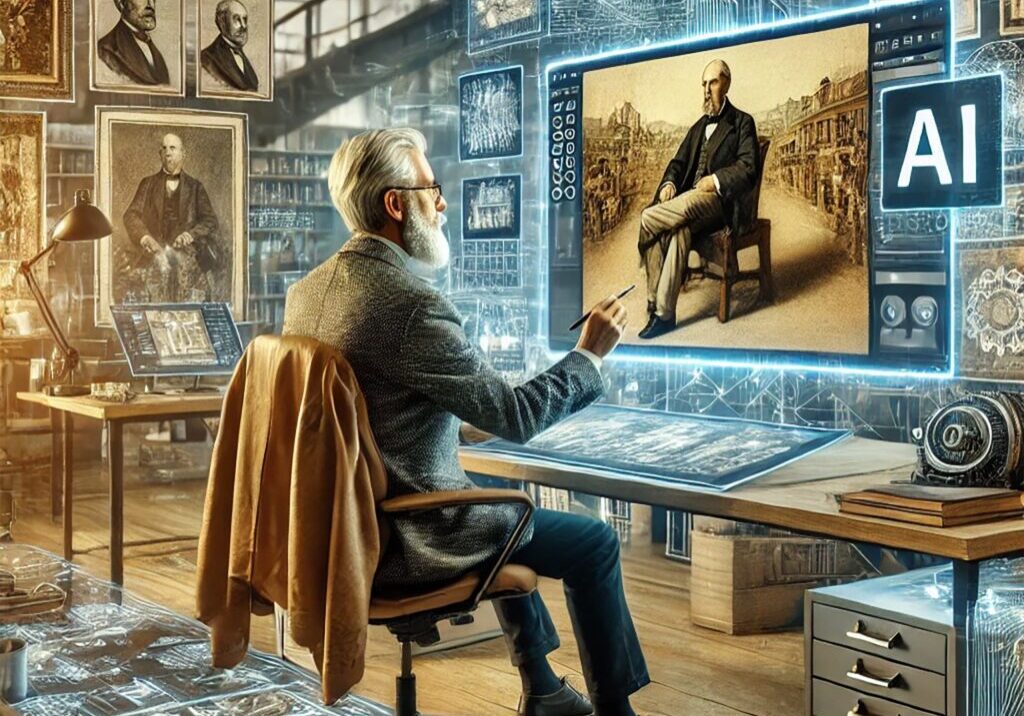
Wheels and Wings: America Takes to the Road and Sky
Introduction
Progress speeds up when wheels touch earth and wings touch sky. There are few shifts in American life more dramatic- or more defining- than the moment the country went mobile. Not metaphorically, but materially. The car and the plane, each in their time, collapsed distance, restructured industry, and altered how Americans saw one another- and themselves.
The 250th Anniversary Mural doesn’t portray this transformation as mere invention. It reveals it as acceleration in all forms- of time, of economy, of imagination. Wheels gave the country reach. Wings gave it altitude. And between the two, a new idea of freedom began to roll forward on roads and soar overhead in open sky. This entry explores how the mural captures that shift- not with diagrams or timelines, but through the textures of motion, the tensions of expansion, and the cultural lift-off that followed.
Automobiles: Democratizing Motion The car in the mural is no showpiece. It’s dirty. It’s working. It’s real. The Model T, nestled within the mural’s midsection, is shown in movement along an unpaved road, flanked by telephone poles and open fields. It’s not a parade. It’s not a racetrack. It’s ordinary life being transformed- households moving, goods transported, families exploring the landscape previously known only by rail or rumor.
This visual signals the start of American motion at a personal scale. Once reliant on train schedules or walking distances, Americans now navigated time and space with newfound autonomy. Roads spread like veins- dusty first, then gravel, then paved. Towns that were once isolated became accessible. Cities restructured their layouts around the automobile, and industries emerged around its care, fueling, and design. The mural honors this transformation not through glamour but grit. Mechanics bend beside wheels. A gas station pump leans into the frame.
Road signs point toward towns whose names might have otherwise faded. We are shown not just technology, but the life it altered. Cars as Culture By the 1920s and 30s, cars had become more than transport- they had become cultural artifacts. In the mural, this shift is hinted at in secondary imagery: a couple on a Sunday drive with the top down. A billboard advertising a new sedan. The start of what would later become car-centric Americana- drive-ins, motels, roadside diners- is foreshadowed here, not yet dominant but unmistakably taking shape. The car becomes a character in the American story- its shape, its speed, its sound. And so does the idea of the open road. The mural doesn’t say it. It suggests it. Motion becomes identity. Flight as Frontier Then the mural shifts upward.
Above the rolling roads and factory rooftops, a glider soars- then a biplane- then a silver-bodied airliner banking into the clouds. The progression is smooth, like the arc of a question being answered. Where once movement was horizontal, it is now vertical. The Wright brothers appear, not as lone geniuses but as part of a lineage- a long arc of human effort to lift, to defy gravity, to transcend terrain. Behind them, sketches float like blueprints coming alive. The mural gives their moment not spectacle, but gravity: this is the moment when the horizon became suggestion, not boundary. Flight changes not only transportation but perception. Americans began to think globally. Mail moved faster. War changed forever. The mural includes a courier plane dropping parachuted packages over an encampment, an airfield forming near a growing city. The sky is not empty. It is now inhabited. From Infrastructure to Imagination Mobility required structure. Highways had to be built. Airstrips had to be carved into land. But the mural does something more- it shows that infrastructure is not just physical. It’s emotional. A young girl waves from a car window.
A boy watches a plane streak overhead. A mechanic smiles beneath an oil-streaked cap. These moments tell us that progress isn’t only about steel and design. It’s about belief in movement- that the future is somewhere you can drive to, or fly toward, if you just keep going. That belief shaped more than industry. It shaped narrative. Road trips became rites of passage. Flight became a metaphor for ambition. And the mural stitches these threads together in a gesture that’s both historic and cinematic. Cultural Acceleration and Its Consequences But motion isn’t neutral.
The mural hints at the shadows beneath mobility’s glow- smog forming over industrial skylines, highways bisecting communities, small towns fading as interstates bypass them. There is cost in speed. There is displacement in convenience. One panel shows a horse-drawn wagon parked beside a paved road, driver dismounted, staring at the cars passing by. Another shows a closed train station, weeds growing on the platform. The mural doesn’t condemn the car or the plane. But it remembers what they replaced. Progress has weight. And the mural carries it.
Why It Still Matters Today we move without thinking. We book flights in seconds. We drive for coffee. But the rise of wheels and wings was once radical. It reoriented everything- geography, commerce, community. It gave the United States new shape, new rhythm, and a new cultural interior- rooted in motion, aspiration, and connection. The mural captures that truth not through idealization, but through integration. Movement is not an isolated theme. It threads through every other- labor, invention, exploration, memory. It becomes how the country thinks. How it becomes.
Further Reading / Explore More
Follow the mural into the skies and deeper into innovation- radio, film, space exploration- each building on the mobility foundations laid here. The mural’s rhythm changes with every wheel turn and wingbeat.
Related Blog: The Steel Backbone: How Factories Forged a New Era Mural Link: https://usa250thanniversarymural.com Tags: 250 Mural, Wright Brothers, Henry Ford, Transportation History, American Progress, Mobility Culture, Early Aviation, Automobile Symbolism, Infrastructure and Change, Public Art and Innovation

